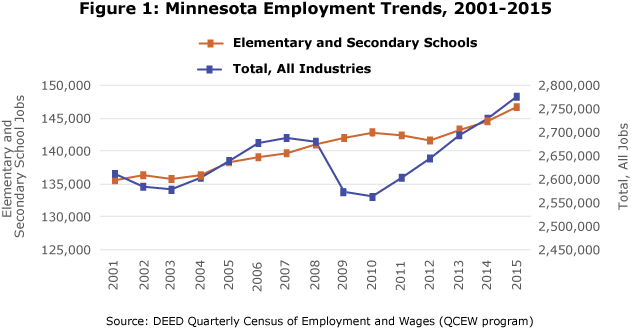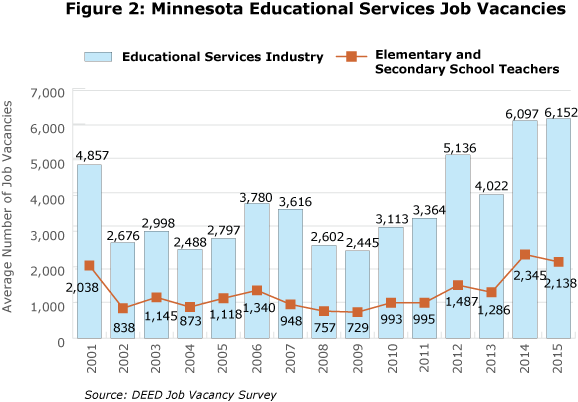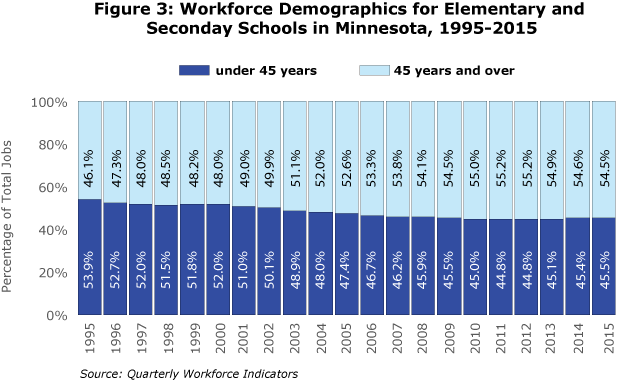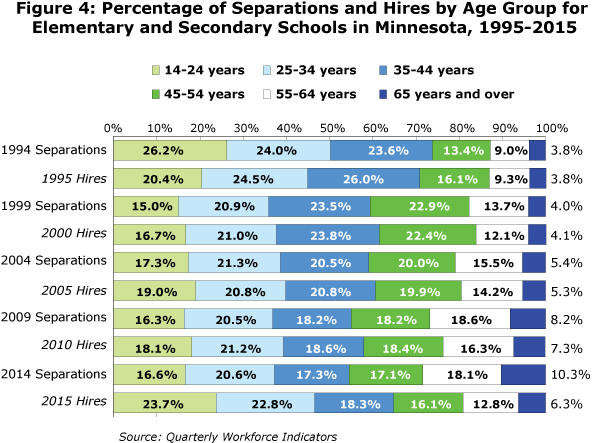by Cameron Macht
August 2016
Not that anyone's counting, but students across Minnesota can likely tell you that there are only between 74 and 104 days of summer vacation until school comes along to end it. Speaking of counting, there were nearly 845,000 students enrolled from kindergarten through 12th grade at Minnesota's 328 public elementary and secondary school districts, as well as nearly 70,000 students enrolled at the 472 non-public schools across the state according to 2015 summary data from the Minnesota Department of Education (MDE).
These 915,000 students won't be the only ones whose summer vacations will be coming to an end – they'll be welcomed back by more than 146,600 workers, the largest number of jobs ever recorded at the state's schools. Data from DEED's Quarterly Census of Employment and Wages program shows steady growth in employment at elementary and secondary schools, making it one of the largest subsectors in the state. Thanks to ARRA funding, schools didn't suffer the same drop in employment as the total of all industries during the Great Recession (see Figure 1).

The largest occupations in the industry include teacher assistants, elementary school teachers, middle and secondary school teachers, special education teachers, and all other teachers and instructors, which will be the focus of this article. But schools also employ many other occupations including education administrators such as superintendents and principals, secretaries and administrative assistants, office clerks, janitors and cleaners, bus drivers, cooks and food prep and serving workers, childcare workers, and coaches and scouts. All of these and many more work together to provide the high quality education that Minnesotans have come to rely on.
Even with the record number of jobs reported in 2015, data from the Job Vacancy Survey demonstrate that demand is at an all-time high for even more workers in educational services. More specifically, the total number of job postings for preschool, primary, secondary, and special education teachers has never been higher in Minnesota. After averaging just over 2,000 vacancies in 2001, demand for teachers mostly stabilized at about 1,000 jobs a year over the course of the next decade. Teaching vacancies then jumped to almost 1,500 in 2012, before reaching a new peak of 2,345 in 2014, then receding slightly to an average of about 2,150 vacancies in 2015 (see Figure 2).

The fastest increases in demand have occurred for preschool teachers and career/technical education teachers, while secondary school teachers had the largest gain in vacancies, which tripled between 2011 and 2015. Likewise, elementary school and special education teachers have also seen significantly increased openings in recent years. Substitute teachers are also in high demand.
But unlike some other industries and occupations, teaching positions do not offer as much flexibility in raising wages to attract new candidates. While median wage offers across all job vacancies have responded to tight labor market conditions by increasing 7.4 percent since 2011, wage offers for preschool, primary, secondary, and special education teachers increased just 1.6 percent. Preschool teachers were the exception, as wage offers started below $10 an hour in 2011 before jumping to $17.51 in 2015, although that was likely related to a rapid increase in the number of employers requiring a certificate or license for those positions (see Table 1).
| Table 1: Minnesota Job Vacancy Details for Teachers, 2011-2015 | ||||||||
|---|---|---|---|---|---|---|---|---|
| Occupation Title | Q2 2011 | Q2 2013 | Q2 2015 | Change in Wage Offers | ||||
| Number of Vacancies | Median Wage Offer | Number of Vacancies | Median Wage Offer | Number of Vacancies | Median Wage Offer | Q2 2011- Q2 2015 | Q2 2013 - Q2 2015 | |
| Total, All Occupations | 54,670 | $12.10 | 72,569 | $12.50 | 97,997 | $12.99 | +7.4% | +3.9% |
| Preschool, Primary, Secondary, and Special Education Teachers | 1,319 | $20.24 | 1,877 | $21.30 | 2,646 | $20.56 | +1.6% | -3.5% |
| Preschool Teachers | 30 | $9.94 | 204 | $11.78 | 347 | $17.51 | +76.2% | +48.6% |
| Elementary School Teachers | 511 | $20.41 | 640 | $21.26 | 737 | $20.68 | +1.3% | -2.7% |
| Middle School Teachers | 90 | $21.91 | 245 | $22.19 | 132 | $21.10 | -3.7% | -4.9% |
| Secondary School Teachers | 251 | $20.26 | 512 | $21.61 | 768 | $21.28 | +5.0% | -1.5% |
| Special Educ. Teachers, Elementary | 289 | $19.85 | 92 | $21.41 | 404 | $19.76 | -0.5% | -7.7% |
| Special Educ. Teachers, Secondary | 126 | $19.78 | 125 | $20.59 | 137 | $21.42 | +8.3% | +4.0% |
| Source: DEED Job Vacancy Survey | ||||||||
Including the loss of learning that typically happens for students over the summer, schools are focused as well on teacher retention. Data from the Quarterly Workforce Indicators program show that the turnover rate for elementary and secondary schools, hovering around 8 percent for the past decade, was lower than the total of all industries in 18 of the last 20 years, including 10 times when it was over 1 percent lower.
However, turnover is an issue for the youngest workers in elementary and secondary schools, with rates reaching close to 30 percent for workers under 25 years of age, before dropping below 10 percent for workers between 25 and 64 years of age. For the most part, once workers get established at their schools, they tend to stay for the long term, but getting established can be a challenge.1
That has led to a shift in the age profile of the elementary and secondary schools workforce over time. In 1995 54 percent of the workforce was under 45 years old, and 46 percent was 45 or older. Over the course of the next two decades while new workers entered and left, existing workers aged, and older workers hung on. As a result, those percentages essentially reversed. By 2010 just 45 percent of the workforce was under 45, while 55 percent were 45 or older.
Once workers reach 65, turnover rates climb above 15 percent again, since many workers decide to retire. To that end, a large portion of the existing workers who have served these elementary and secondary schools so well for so long appear to be aging out of the workforce. The percentage of workers under 45 hadn't seen a year-over-year increase since 2000, but has now shown three straight years of gains from 2012 to 2015 (see Figure 3).

Quarterly Workforce Indicators track this turnover activity by comparing the number of hires, an estimate of workers who started a new job or were recalled in the specified quarter, and separations, the number of workers whose job with a given employer ended in the specified quarter. With nearly half of new hires last year being workers under 35, 2015 was the best year for hiring young workers in the past 20 years, while the percentage of separations from workers aged 55 and over in 2014 was the second highest recorded, surpassed only by the previous year.
With older workers now comprising a larger percentage of the total workforce, it makes sense that they would comprise a larger percentage of the separations over time. But the recent surge in hiring among the youngest age groups is perhaps a sign of things to come as more workers age out of the workforce (see Figure 4).

Recent graduates with dreams of working in education will find an improved job market that is packed full of opportunities. Data from DEED's Graduate Employment Outcomes tool show that students from education-specific programs have found success in the labor market.
Colleges and universities in Minnesota have graduated an average of about 6,500 students a year from various education programs over the past five years, the largest number being graduate students. Many of these completers are current teachers who are increasing their education to increase their wages through Teacher Education and Professional Development programs. The second largest graduate level program is Education Administration and Supervision, which trains workers to take on roles such as principals and superintendents. Median wages for graduates from these programs were consistently above $30 an hour.
About 2,500 people a year graduate from education programs with bachelor's degrees, with nearly 80 percent concentrated in Teacher Education and Professional Development programs that prepare elementary, middle school, and high school teachers. Despite the significant identified shortage of teachers for students with emotional behavior disorders, learning and developmental disabilities, and English Language Learners, it's surprising to see just 5 percent of these graduates focused on Special Education.2
More than twice as many people earned graduate degrees as earned bachelor's degrees in Special Education. Many of the teachers currently working in Special Education are doing so using special permissions approved by the Minnesota Board of Teaching. This has become a larger issue for school districts that are unable to hire fully licensed teachers for particular teaching assignments and may then be eligible to use non-Licensed Community Experts, innovative program waivers, and general or special education variances.3
Although in much smaller numbers, demand was also steady for graduates from education programs awarding certificates and associate degrees. However, wages were also much lower with a large portion of these graduates finding work in preschool and child care settings instead of elementary and secondary schools or working as teacher assistants rather than lead teachers (see Table 2).
| Table 2: Employment Outcomes for Minnesota Graduates in Education Instructional Programs One Year After Graduation, 2009-2014 | ||||||||||
|---|---|---|---|---|---|---|---|---|---|---|
| - | 2009-2010 | 2010-2011 | 2011-2012 | 2012-2013 | 2013-2014 | |||||
| Number | Median Wage | Number | Median Wage | Number | Median Wage | Number | Median Wage | Number | Median Wage | |
| Education | 6,403 | $25.60 | 6,642 | $24.31 | 6,677 | $24.20 | 6,224 | $24.40 | 6,380 | $26.64 |
| Certificates | 81 | $12.55 | 86 | $17.85 | 67 | $11.89 | 113 | $11.91 | 145 | $12.10 |
| Associate degrees | 156 | $12.31 | 190 | $11.83 | 251 | $12.21 | 204 | $11.99 | 260 | $12.10 |
| Bachelor's degrees | 2,446 | $16.48 | 2,520 | $16.39 | 2,674 | $17.74 | 2,308 | $18.40 | 2,265 | $20.55 |
| Graduate degrees | 3,700 | $32.95 | 3,829 | $34.35 | 3,685 | $30.82 | 3,599 | $30.55 | 3,710 | $33.93 |
| Source: DEED Graduate Employment Outcomes (GEO) tool | ||||||||||
After the number of public and private high school graduates declined in recent years, the Minnesota Office of Higher Education is projecting 3.9 percent growth over the next 10 years. Minnesota's elementary and secondary schools are also expected to continue adding jobs, projected to grow about 1.5 percent in the next decade, with slightly faster expansion expected at private schools than at public schools.
That may not sound like much room for growth, but that is only an estimate of new jobs added that don't currently exist. Instead, the more significant demand for new workers is expected to come from the need to fill behind retirements and other career changers. DEED's Employment Outlook tool also provides estimates of the number of replacement openings, which outnumber new jobs in teaching occupations by more than 14 to 1. For every new job created, 14 more current teaching jobs will need to be filled as experienced workers leave an occupation and start working in another occupation, stop working altogether, or leave the geographic area (see Table 3).
| Table 3: Minnesota Employment Projections for Preschool, Primary, Secondary, and Special Education Teachers, 2014-2024 | ||||||
|---|---|---|---|---|---|---|
| Occupation | Estimated Employment 2014 | Projected Employment 2024 | Percent Change 2014 - 2024 | Numeric Change 2014 - 2024 | 2014 - 2024 Replacement Openings | 2014 - 2024 Total Openings |
| Preschool, Primary, Secondary, and
Special Education Teachers |
78,957 | 80,243 | +1.6% | +1,286 | +18,170 | +19,460 |
| Teacher Assistants | 31,667 | 32,346 | +2.1% | +679 | +7,590 | +8,270 |
| Elementary School Teachers | 27,685 | 28,131 | +1.6% | +446 | +6,120 | +6,570 |
| Secondary School Teachers | 19,315 | 19,630 | +1.6% | +315 | +4,580 | +4,895 |
| Preschool Teachers | 7,457 | 7,630 | +2.3% | +173 | +2,180 | +2,350 |
| Middle School Teachers | 9,726 | 9,880 | +1.6% | +154 | +2,150 | +2,300 |
| Special Education Teachers,
Preschool and Elementary |
5,751 | 5,797 | +0.8% | +46 | +1,080 | +1,130 |
| Special Education Teachers, Secondary | 5,336 | 5,431 | +1.8% | +95 | +1,000 | +1,095 |
| Education Administrators,
Elementary and Secondary |
3,214 | 3,265 | +1.6% | +51 | +940 | +990 |
| Kindergarten Teachers | 3,125 | 3,174 | +1.6% | +49 | +920 | +970 |
| Education Administrators,
Preschool/Childcare |
1,382 | 1,425 | +3.1% | +43 | +400 | +440 |
| Career/Technical Education Teachers | 562 | 570 | +1.4% | +8 | +130 | +140 |
| Source: DEED 2014-2024 Employment Outlook | ||||||
Although the racial diversity of Minnesota's elementary and secondary school students has changed greatly over the past 30 years, the diversity of the industry's workforce has not. According to MDE data, minorities made up about 30 percent of the public school students in 2015, but just 8 percent of the workforce (see Tables 4 and 5).
| Table 4: Race and Ethnicity of Public School Students, 2015 | |
|---|---|
| Race | Students |
| White alone | 70.5% |
| Black or African American | 11.5% |
| American Indian | 2.4% |
| Asian or Pacific Islander | 7.2% |
| Hispanic or Latino | 8.4% |
| Source: Minnesota Department of Education | |
| Table 5: Race and Ethnicity of Elementary and Secondary School Workers, 2015 | |
|---|---|
| Race | Workers |
| White alone | 93.8% |
| Black or African American | 2.9% |
| American Indian | 0.6% |
| Asian or Pacific Islander | 1.8% |
| Two or more races | 0.9% |
| Hispanic or Latino | 2.0% |
| Source: Quarterly Workforce Indicators | |
Encouragingly, the number of minority students and minority workers both increased 45 percent in the past decade. That was an increase of nearly 80,000 minority students and 3,880 minority workers. Still, about 94 percent of the elementary and secondary schools workforce was white alone, compared to 70.5 percent of the student population.
Minnesota's elementary and secondary schools are setting the foundation for the state's future, both as a source of education and as a source of employment. Demand for teachers is strong and should stay that way in the next decade as a large portion of our current teachers, who have served us so well for so long, reach retirement age and open the door for a new wave of more diverse teachers to reach a more diverse student population.
1Post, Tim. "Young teachers need mentoring to thrive, survive." October 29, 2014.